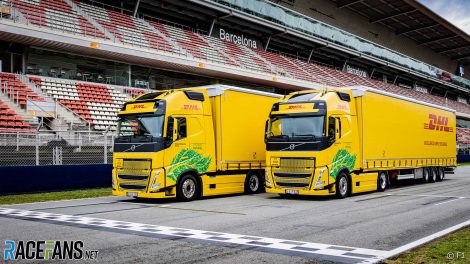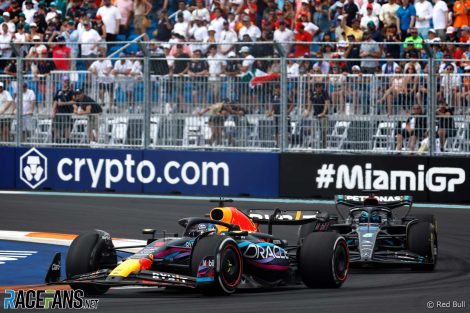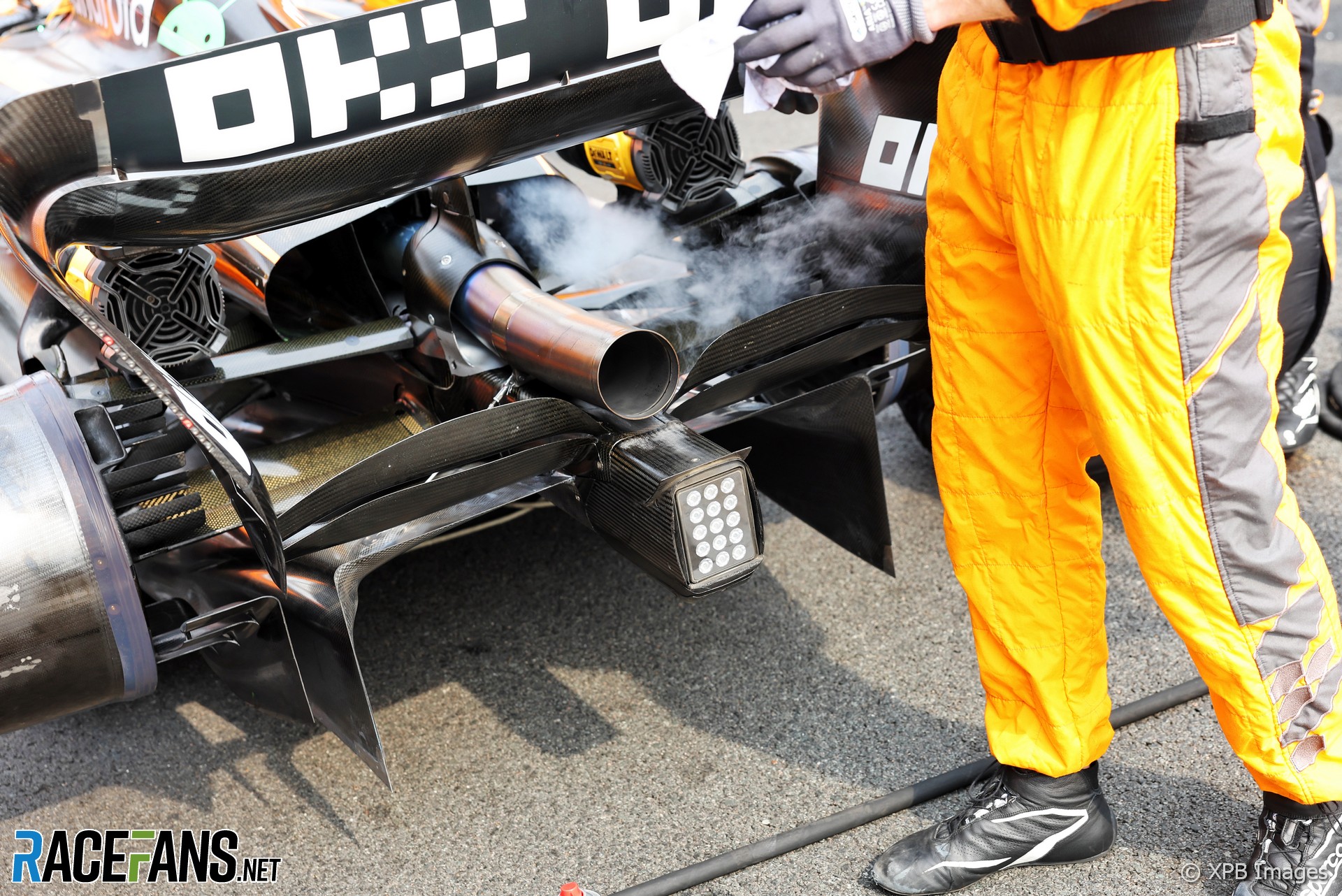Formula 1 has revealed the progress it is making towards reducing its carbon emissions to “net zero” by 2030.
The series announced its goal four years ago after analysing the emissions produced by the world championship throughout 2018. It found F1’s annual CO2 emissions totalled 256,551 tons at the time, the majority of which came from logistics and business travel.Since then F1 has begun introducing measures to reduce its emissions, such as switching its offices to renewable energy tariffs and increasing the use of remote working to cut travel.
The series’ efforts to cut its emissions were disrupted by the Covid-19 pandemic, which led to the cancellation of many races in 2020, most of which were restored to the calendar the following year.
Formula 1’s head of environment, social and governance Ellen Jones said F1 is pleased with the progress it has made in reducing its emissions so far. “We have been reducing our carbon footprint,” she said in response to a question from RaceFans. “Our last carbon footprint was 2021 and that was a 17% reduction based on our 2018 baseline.”
A 17% reduction indicates a cut of around 43,000 tons of CO2 compared to 2018, meaning total emissions in 2021 were around 212,000 tons.
“It’s fantastic,” said Jones. “But it is something that you have to make sure we’re comparable year to year, given the fact that we have had consolidated seasons changes to what that is.”
Advert | Become a RaceFans supporter and
The 2021 season had 22 races, one more than in 2018, however two of those were held at the same venue on consecutive weekends, reducing the amount of travel necessary. The number of races outside of Europe, the teams’ home continent, rose from nine in 2018 to 12 in 2021.

This year the cancellation of the Emilia-Romagna Grand Prix at Imola due to flooding has reduced the number of European races this year to nine, with 13 rounds in further-flung destinations.
F1 announced yesterday it will reduce the emissions generated by the fleet of trucks which takes the series’ equipment to the European rounds on this year’s calendar.
The series’ logistics provider DHL is using 18 new trucks running on a fuel based on hydrotreated vegetable oil, which it says will reduce emissions by a minimum of 60%. HVO100 is a second-generation biofuel which does not compete with sources of food production.
The 10 teams transport their hardware separately. Mercedes announced last week it is also using HVO100 to fuel its teams’ trucks this year following a successful trial during 2022.
Advert | Become a RaceFans supporter and
Jones said F1 intends to cut its emissions by at least half in order to reach its 2030 target.

“So that’s why it’s not just that are we looking for future technologies, which is fantastic and we could have a whole press conference on the R&D potential and sustainable fuels. But when it comes to delivering net zero by 2030, it’s how do we look at how we materially change our operations to ship less, to travel a shorter distance, to ensure what does travel has been ‘light-weighted’, reviewed – and could it be locally sourced?
“Those are the actions that aren’t dependent on technology change, they’re actually the actions that are dependent on a culture change of each and every single individual in F1 understanding what their role is and how they their decisions impact our overall net zero by 2030. And the technology innovations are fantastic and just help us make those leaps as opposed to the steps.”
F1 intends to make further emissions savings by rearranging its schedule to reduce travel. The 2023 F1 calendar includes a number of long or repeated journeys such as races in Azerbaijan and the USA on consecutive weekends, and three separate transatlantic return trips.Jones said F1 CEO Stefano Domenicali is working on tackling the obstacles to reorganising the calendar in order to address concerns.
“We completely understand that rationalisation is a key goal and it’s one that Stefano, our CEO, has advocated for,” she said. “And it is also a partnership with our promoters.
“When you have a calendar and a date, it can be a very emotive topic [for a race promoter]: it’s a holiday, ‘it’s always been that’. But we need to bring them on that change journey with us so that we can host more sustainable events, reduce our carbon footprint and balance all of those variables.”
Bringing the F1 news from the source
RaceFans strives to bring its readers news directly from the key players in Formula 1. We are able to do this thanks in part to the generous backing of our RaceFans Supporters.
By contributing £1 per month or £12 per year (or the equivalent in other currencies) you can help cover the costs involved in producing original journalism: Travelling, writing, creating, hosting, contacting and developing.
We have been proudly supported by our readers for over 10 years. If you enjoy our independent coverage, please consider becoming a RaceFans Supporter today. As a bonus, all our Supporters can also browse the site ad-free. Sign up or find out more via the links below:
Advert | Become a RaceFans supporter and
2023 Spanish Grand Prix
- Ben Sulayem raises safety concerns over “too many people on the grid” at races
- Why Ferrari say their change in design is the result of “discipline”, not “copying”
- Hamilton and Russell were seeking tow from Sainz when they collided – Mercedes
- Red Bull’s Spanish GP diffuser update was ‘inspired by rivals’ including Williams
- Why McLaren always doubted second-row start in Spain would lead to points finish





BasCB (@bascb)
2nd June 2023, 8:49
Good to see they are working at it, although it remains to be seen how much of that “old cooking oil” stuff will be available for the market to actually use (for now I will trust that the EU directive that was used to calculate they reduce emissions by 90% vs fossil fuels is more or less correct).
The biggest tasks remaining are 1. reducing energy use at the plants – CFD and Windtunnel, this is probably doable. 2. Making serious inroads on finding a way to fly more sustainably, not sure that one is really ontrack and 3. start taking visitors emissions into account as well, since that is almost certainly a boatload of emissions that are currently not taken in account when they talk about net zero and reduction of emissions at all.
Jere (@jerejj)
2nd June 2023, 9:48
@bascb I agree with you thoroughly, although the general temporary/city circuit trend addresses the visitor impact to a good extent.
BasCB (@bascb)
2nd June 2023, 12:47
Good point about that positive effect of having a race in a place where a lot of people live. Off course still many travel long distance to get there, but certainly not as many as a race in the middle of nowhere. And public transport can ideally be used to good effect (I’d say Melbourne, Montreal and Mexico are probably top notch in that aspect)
Jere (@jerejj)
2nd June 2023, 9:47
Unsurprisingly, PU, or the driving on circuits itself, produces the lowest amount from the overall footprint, with logistics the biggest contributor.
Nevertheless, good thing that some progress has got made so far & regarding the race calendar reorganization plan:
As regionalized as possible, given climatic conditions limit flexibility to an extent, & more specifically for this season, four separate transatlantic trips, given the LV GP occurs separately from the COTA & Mexico City events, not to mention, no Middle East double-headers this season (possibly also not next season) adds to matters.
Elvira
2nd June 2023, 12:47
I’m not sure how they’re doing their creative accounting but 17% over three years that saw less races than they have now wouldn’t appear to be on track for the stated goal.
Johns
2nd June 2023, 14:15
Its all virtue signaling. Meaningless goals get meaningless effort.
ryanoceros (@ryanoceros)
2nd June 2023, 16:03
They need busses to the races for spectators where public transit is not available. The carbon emissions of 100,000 cars idling to get out of poorly designed car parks is unnecessary.